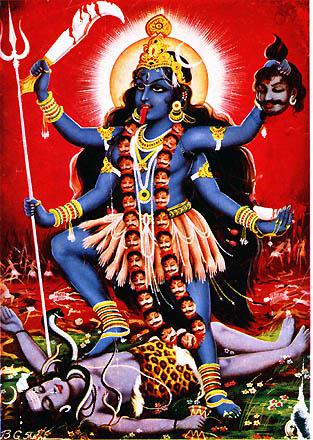It is well known that the modern world religions which trace their origins to the Axial Age are centrally concerned with death. Some might call this concern an obsession. Of these world religions, only Hinduism does not have Axial roots. This is not to say that “Hinduism” (which is neither singular nor unified) was unaffected by Axial ideas. Those who had such ideas broke from traditional Hinduism and became the progenitors of Jainism and Buddhism, both of which are Axial. Although not an Axial tradition, Hinduism shares an Axial concern or obsession with death.
In “Death and Deification: Folk Cults in Hinduism,” Stuart Blackburn addresses this concern and notes it is not limited to high-caste and literate Brahmins:
As a source of Indian religious thought, death is probably unsurpassed; no matter which historical period or cultural level one chooses to examine, concepts lead to or from the problems it presents. Beneath their cosmic purposes, Vedic sacrifices were designed to ward off death temporarily and attain a full life span for men….And even the process of samsira, the foundation of Indian thought, was first understood not as a rebirth but as continual “redeath” (punarmrtyu).
In the social world, if purity and impurity have anything to do with the way Hindus perceive and organize it, death is all the more central because it is the single most polluting human experience. And even if the pure/impure dichotomy is not the organizing principle of Hindu life, an opposition between death and life may be; this is the conclusion of several important studies of Sanskrit ritual and literary texts, and one confirmed by my own work with an oral tradition…[T]he popular streams of Hinduism, no less than the high-status ones, are centered on death.

Blackburn is not alone in his assessment. In The Origins of Evil in Hindu Mythology, renowned Indologist Wendy Doniger comments: “Much — some might even say all — of Indian religion is dedicated to the attempt to achieve immortality in one form or another.”
What is up with all this death obsession? Some, such as Ernest Becker in The Denial of Death, claim that humans are universally obsessed with death and all of life is governed by our attempts to deny or thwart it. Although Becker was a cultural anthropologist, he apparently did not read much ethnography or ethnohistory. Had Becker done so (and not immersed himself in existential psychoanalysis), he would know that death obsessions are not a human universal.
We are fortunate to have a substantial ethnohistoric and ethnographic record of hunter-gatherers. Although large portions of this record remain unpublished and languish in archives, anyone who has spent much time with this record knows that hunter-gatherers do not devote much time, energy, or thought to the fact of death and death’s supernatural concomitants: afterlife and/or rebirth.
There are reasons why late Neolithic and Axial religions are so concerned with death and are sometimes characterized as “world rejecting.” There likewise are reasons why hunter-gatherers are not so concerned and their “religions” (or more aptly, supernaturalism) are characterized as “world affirming.” I have several reasons in mind but am interested in your thoughts. Any ideas?
Reference:
Blackburn, Stuart H. (1985). Death and Deification: Folk Cults in Hinduism History of Religions, 24 (3), 255-274



